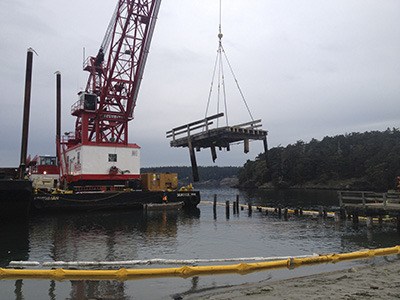Friends of the San Juans partnered with the Washington State Department of Natural Resources and the Tulalip Tribes to remove creosote pilings and a pier in Barlow Bay off of Lopez Island.
This project improves water quality, eelgrass growing conditions, and upper beach habitat at a documented Pacific sand lance spawning site.
Creosote-treated wood was commonly used in marine structures throughout the Salish Sea for more than a century during a period of rapid development and industrial expansion. Like other chemical compounds that were innovations in their time, creosote was broadly used without knowledge of its long-term consequences. It is now known that creosote contains more than 50 carcinogens and is toxic to marine fish and other wildlife.
“Research has shown that herring eggs exposed to creosote have a high mortality rate,” said Tina Whitman, Friends’ science director. “Chemicals found in creosote also affect juvenile salmon that migrate through contaminated estuaries by reducing their growth and altering immune function.”
Twenty-six in-water creosote pilings and approximately 1,200 square feet of remaining overwater structure (pier decking) was removed from Barlow Bay. In addition, 200 square feet of upper beach habitat will be unburied by removing rock and fill, as well as other debris including concrete, creosote and tires.
DNR’s Creosote Removal Program is leading the effort to remove treated wood from public and private property throughout the Salish Sea. Since the program began in 2004, DNR and partners have removed more than 14,000 tons of derelict pilings, 250,000 square feet of treated overwater structures such as docks and piers, and 2,700 tons of treated beach debris.
“We’re having great success removing these toxic materials from Washington’s marine waters,” said Monica Shoemaker, manager of DNR’s Creosote Removal Program. “We’re well on the way to achieving cleanup goals laid out in the Puget Sound Action Agenda, thanks to great partners such as the Friends and the Tulalip Tribes.”
For more information about this project, contact Whitman at 378-2319.
Funding for the creosote-removal projects comes from the Washington State Salmon Recovery Funding Board and the state’s Jobs Now Act.



